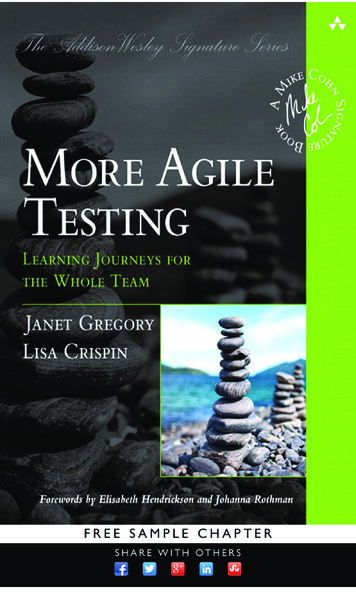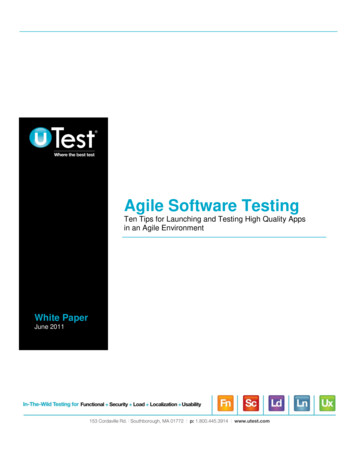
Transcription
Agile TestingLearning Outcomes
LICENSING INFORMATIONThe work in this document was facilitated by the International Consortium for Agile(ICAgile) and done by the contribution of various Agile Experts and Practitioners. TheseLearning Outcomes are intended to help the growing Agile community worldwide.This work is licensed under the Creative Commons Attribution-NonCommercialNoDerivatives 4.0 International License. To view a copy of this license, visit http://creativecommons.org/licenses/by-nc-nd/4.0/ or send a letter to Creative Commons, POBox 1866, Mountain View, CA 94042, USA.YOU ARE FREE TO:Share — copy and redistribute the material in any medium or formatUNDER THE FOLLOWING TERMS:Attribution — You must give appropriate credit to The International Consortium forAgile (ICAgile), provide a link to the license, and indicate if changes were made. Youmay do so in any reasonable manner, but not in any way that suggests ICAgileendorses you or your use.NonCommercial — You may not use the material for commercial purposes.NoDerivatives — If you remix, transform, or build upon the material, you may notdistribute the modified material.NOTICES:You do not have to comply with the license for elements of the material in the publicdomain or where your use is permitted by an applicable exception or limitation.No warranties are given. The license may not give you all of the permissions necessaryfor your intended use. For example, other rights such as publicity, privacy, or moralrights may limit how you use the material.PAGE 2LICENSING INFORMATION
SPECIAL THANKSICAgile would like to thank the contributors to theAgile Testing Learning Outcomes:Janet Gregory Jeff Payne Sharon RobsonPAGE 3SPECIAL THANKS
CONTENTS2 LICENSING INFORMATION3 SPECIAL THANKS4 TABLE OF CONTENTS5 HOW TO READ THIS DOCUMENT6 LEARNING OUTCOMES6 1. AGILE TESTING MINDSET6 1.1. Overview of Agile Testing6 1.2. Mindset & Culture7 2. TESTING TECHNIQUES7 2.1. Categories of Testing8 2.2. Collaborating with Developers8 2.3. Example Driven Development8 2.4. Feature and Story Testing9 3. AGILE TESTING PROCESS9 3.1. Roles and Responsibilities10 3.2. Test Strategy and Planning11 3.3. Successful Delivery12 3.4. Test Environments and Infrastructure13 3.5. Working on Distributed TeamsPAGE 4CONTENTS
HOW TO READ THIS DOCUMENTThis document outlines the Learning Outcomes that must be addressed by accreditedtraining organizations intending to offer ICAgile’s Agile Testing Certification.Each LO follows a particular pattern, described below.0.0.0. Learning Outcome NameAdditional Context, describing why this Learning Outcome is important or what itis intended to impart.The Learning Outcome purpose, further describing what is expected to beimparted on the learner (e.g. a key point, framework, model, approach,technique, or skill).PAGE 5HOW TO READ THIS DOCUMENT
LEARNING OUTCOMES1. AGILE TESTING MINDSET1.1. OVERVIEW OF AGILE TESTING1.1.1. Origins of Agile TestingMany people who hear about Agile testing for the first time assume that it wascreated as part of the Agile movement. In actuality, much like Agile itself, manyof the Agile testing techniques where espoused well before the Agile Manifestowas created.Explain and anchor the ideas of Agile testing in earlier work, giving the learnerscontinuity from the past to the present.1.1.2. Agile Testing vs. Traditional ApproachesAgile testing is much different from testing performed during traditional softwaredevelopment approaches.Compare and contrast the major differences between Agile testing and testingperformed as part of traditional (phased-based) software developmentapproaches in which testing is primarily performed by software testers who areoften in their own organization and sometimes only involved late in thedevelopment life-cycle.1.2. MINDSET & CULTURE1.2.1. Agile Testing PrinciplesThe Principles behind the Agile Manifesto establish guiding principles for not onlythe Agile movement but Agile testing as a discipline.Explain how the Agile Manifesto is realized within an Agile testing process andapproach.1.2.2. Whole Team ApproachQuality is not “owned” by a particular role in Agile. It is a property of software thatthe entire team must make sure is present before software is released tocustomers.Explain that quality is everyone’s responsibility during Agile projects andeveryone is involved in software testing. Testers are often ideally suited to guidethe team toward achieving its quality goals and its definition of “done” based onteam definitions of the quality attributes for the product. The role each teammember typically plays for quality will be discussed.1.2.3. Building Quality InThe role of a tester shifts in Agile from that of quality gate keeper to a facilitatorwho supports the team through asking questions to help clarify understanding, aswell as testing and critiquing the product.PAGE 6LEARNING OUTCOMES
Demonstrate the mindset shift of testers from that of an independent groupresponsible for gating the development process to a collaborative team memberfocused on improving the product and releasing value to the customer.1.2.4. Continuous Improvement and FeedbackAgile testing provides critical insights and feedback into the software process thatcan be used to drive team and quality improvements and assist the organizationin making informed business decisions regarding software release.Explain that Agile testing is a critical feedback component when seeking toimprove operational effectiveness.1.2.5. Ingraining the Agile Mindset (Hands-on Exercise)Practicing behaviors can solidify the mindset and culture of Agile testing.Practice situations in which the Agile testing mindset is likely to be different, sothe learner can internalize the difference experientially, not just in concept.2. TESTING TECHNIQUES2.1. CATEGORIES OF TESTING2.1.1. Agile Testing Quadrants or CategoriesTesting activities can be broken into various categories of testing based upontheir purpose and value. Types of testing are often broken into categories thatinclude: testing that supports project team development efforts, testing that looksat quality from a business perspective, testing that critiques the product andtesting that exercises the relationship between software and its deploymentplatform.Explain and categorize the purpose of various testing techniques so they can beapplied appropriately and at the right time within an Agile environment.2.1.2. Automation Pyramid - IntroductionAutomated testing can be performed at various levels within a softwareapplication. An automation pyramid or structure describes these various levelsand discusses the approach and likelihood of automating tests within each ofthem.Explain the various types of testing that can be automated and how decisions getmade regarding what to automate during an Agile project.2.1.3. Testing TechniquesTest design techniques are necessary in an Agile environment, they need toincorporate existing techniques and extend and apply them to the collaborativemethods.Apply some simple ideas about approaching test design; For example mindmapping, context diagrams and other methods conducive to a collaborativeenvironment.PAGE 7LEARNING OUTCOMES
2.2. COLLABORATING WITH DEVELOPERS2.2.1. Unit and Component TestingDeveloper testing of individual software units and associated components iscritical to detecting implementation defects within software. Unit and componenttests are leveraged within TDD as well.Demonstrate the purpose and approach to successfully implementing unit andcomponent testing on Agile projects and show how testers support developertesting during development cycles.2.2.2. Pairing between the Developer and TesterAdditional testing techniques beyond unit/component testing are often necessaryto test beneath the UI level.Explain how developers and testers pair during fixture / test method developmentand API-level testing.2.3. EXAMPLE DRIVEN DEVELOPMENT2.3.1. Acceptance Test-Driven Development (ATDD)ATDD is a common technique for assuring that Stories are implemented in amanner that satisfies the exit criteria defined for Story completion. It is often usedas a technique to test Stories but in actuality includes the testing of key businessprocesses and non-functional requirements as well.Explain the purpose and approach to successfully implementing AcceptanceTest-driven Development (ATDD) on Agile projects.2.3.2. Behavior-Driven Development (BDD)BDD is an alternative approach to ATDD that is sometimes used to test Stories,Business Process and non-functional Requirements based upon anunderstanding of user behavior.Explain purpose and approach to successfully implementing Behavior-drivenDevelopment on Agile projects.2.3.3. Spec by ExampleSpecification by example uses the 3 amigos idea in a workshop environment toexpress examples.Explain the terminology and how it is different / same as ATDD and BDD.2.4. FEATURE AND STORY TESTING2.4.1. User Story TestingTesting of User Stories is critical to successful development of software within anAgile project. This testing is often performed using the techniques above but canbe done in other ways as is appropriate or necessary.PAGE 8LEARNING OUTCOMES
Demonstrate User Stories are tested during software development; this is anextension to ATDD to include boundary conditions and other types of testing suchas exploratory testing.2.4.2. Feature TestingWhile the above techniques are the most common, there are a variety of othertesting techniques that can be applied to test software features.Explain and categorize the bigger picture beyond a user story (work-flows, endto-end scenarios).2.4.3. Exploratory TestingExploratory testing provides a mechanism for additional testing to be performedon Stories or Business Processes based upon a tester’s intuition and knowledgeabout the product.Describe and apply Exploratory Testing techniques and approaches and explainhow they are best applied to an Agile project. Introduce the idea that automationcan support ET.2.4.4. Non-Functional TestingNon-functional, or Quadrant 4 tests are sometimes ignored by customers. Thereis no clear understanding of who is responsible for it.Explain how to include testing these quality (non-functional) attributes in ourtesting.3. AGILE TESTING PROCESS3.1. ROLES AND RESPONSIBILITIES3.1.1. Team-Based Testing ApproachTesting during an Agile project is team-oriented wherein it is common for everymember of the team to provide some level of testing support.Explain that within an Agile project, the entire project team is responsible for testplans, test design, test cases, test automation and test reporting.3.1.2. Typical Business Representative Role in TestingBusiness Representatives typically provide guidance on acceptability and provideexamples of what Stories are intended to accomplish.Explain the common test activities that a business representative is involved withduring an Agile project.3.1.3. Typical Programmer Role in TestingSoftware programmers typically build, automate and run a variety of tests at avariety of levels as part of their development process. TDD and ATDD leveragesthis testing to improve design and development.Explain the role software programmers play in Agile testing.PAGE 9LEARNING OUTCOMES
3.1.4. Typical Tester Role in TestingSoftware testers typically work hand-in-hand with the product owner andprogrammers to plan, execute and report on the testing that is performed at alllevels.Explain and classify the role software testers play in Agile testing. Skills shouldinclude technical awareness; T-shaped skill-set.3.1.5. Role of Test Managers in AgileWhen an organization has decided to organize around products or projects, testmanagers are often left to wonder what their role within this new structure will be.Explain the new role that a test manager plays and the reason behind the shift.For example, mentoring test communities of practice and helping coordinatepost-development testing activities.3.2. TEST STRATEGY AND PLANNING3.2.1. Different Strategies Based on Levels of PrecisionLightweight planning is typically part of the release planning done prior toassociated iterations.Demonstrate how lightweight test strategy and planning is performed duringrelease planning and how decisions are made regarding what type of testdocumentation is needed and how much is enough.3.2.2. During Iteration Planning/KickoffTest planning at iteration kickoff focuses on detailing acceptance criteria andexamples for Stories.Demonstrate how tests are developed prior to implementation.3.2.3. Lightweight Test Plan DocumentationTest planning in Agile is different from traditional development approaches as thegoal is to provide the least amount of documentation needed to get the job done.Explain how to determine the amount of test documentation necessary for agiven environment or situation.3.2.4. Defect Tracking and ManagementThe amount of defect tracking that is performed during an Agile project dependsupon what works best for the team.Explain the key trade-offs for determining which defects to track and which to relyupon team communication to correct without tracking.3.2.5. Results ReportingTest reporting during Agile projects depends upon what works best for the team.Explain the key trade-offs between documented test results and teamcommunication of those results.3.2.6. Test MetricsPAGE 10LEARNING OUTCOMES
Metrics collected to support test completeness and release readiness decisions.Example: determining whether a story, feature or/ iteration is "Done".Explain which metrics make sense to collect and report on for both testcompleteness and release readiness within an Agile project.3.2.7. Regression TestsAutomated regression tests are essential to reducing the cost of change andproviding real-time feedback during the development process.Show how to best leverage tests that have been automated during developmentwithin future iterations and releases.3.3. SUCCESSFUL DELIVERY3.3.1. Time-Boxed DeliveryTime-boxed delivery means that at the end of every iteration, there is apotentially shippable product, including testing.Explain that all work on a story needs to be completed within the iteration andtime must be allocated by the team to allow that to happen. Testing and codingshould be planned for concurrency not sequential work. Testing and coding are tobe considered one process not two steps.3.3.2. Continuous DeliveryContinuous delivery means that every build has the potential to be deployed toproduction.Explain what this means to testing. Inclusion of automation, responsiveness todefects and change. Explain how aspects of testing that enable continuousdelivery in a team are captured and incorporated into the work flow.3.3.3. Post-Development Test CyclesIn Agile, testing is as early as possible for fast feedback, but during the endgame,there is often final testing that needs to happen.Describe the interaction of testers in post-development test cycles. This includesintegration test teams that take advantage of economies of scale for securitytesting, browser compatibility, interoperability, etc. in an integrated environment. Italso includes testing in the End Game for final UAT, or final performance testing.3.3.4. Iteration Wrap-UpWrap-up activities during an iteration include a product demo, retrospective andsometimes a User Acceptance Test.Explain of the role that software testers play during iteration wrap-up activities.3.3.5. Definition of a Release/End GameA release process (aka “end game”) is performed whenever a decision has beenmade by the business to release software to customer(s).Explain how a release decision is made and what testing activities are typicallypart of the release process.PAGE 11LEARNING OUTCOMES
3.3.6. User Acceptance Testing (UAT)User Acceptance Testing is used within Agile to gain customer feedback on aworking piece of software before its release.Demonstrate user acceptance testing (UAT) techniques and approaches andhow they are best applied to an Agile project.3.3.7. System-Wide and Cross-team TestingThe focus needs to be on products and solutions not on projects. Thereforetesting needs to maintain the big picture that spans beyond the individual projectand crosses over to multiple teams or projects to a more system-wide view oftestingExplain how to coordinate testing across Agile projects and associated testingactivities when the project must interact/interface with other projects and ITtechnology release schedules.3.3.8. Post-Release TestingTesting after software release typically consists of testing "hot fixes" for criticaldefects identified in the field and ongoing testing of bug fixes not fixed prior torelease.Explain the types of testing that is performed post release and how continuoustesting supports a continuous delivery process.3.3.9. Documentation for Regulatory RequirementsDemonstrate how regulatory requirements can still be fulfilled when following anAgile development process.Prepare a set of tests based on regulatory requirements and show how they canbe incorporated into the testing cycles.3.4. TEST ENVIRONMENTS AND INFRASTRUCTURE3.4.1. Typical Environments for TestDescribe typical test environments that must be set up and maintained to supporttesting activities during iterations and releases. This needs to include informationabout the tool and data setups as well.Discuss the characteristics and typical definitions test environments. Justify whyeach type of testing needs a defined environment to match the purpose of thetests being run.3.4.2. Build PipelineExplain how the build pipeline works to help determine which testing isappropriate for which test environment. What needs to happen before the build isdeployed to the next stage?Discuss the product maturity as it moves through the levels of test automationthat can be applied.3.4.3. Automated BuildsPAGE 12LEARNING OUTCOMES
Explain how automated builds are set up to support a continuous testing process.Explain why automated build processes are valuable and how they supportcontinuous testing.3.4.4. Testing the Proper BuildDiscuss the best practices associated with choosing a build for test and keepingdevelopment and testing in sync during the process.Describe how to choose a build for testing and explain the factors influencing thedecision.3.4.5. Test Data ManagementDiscuss traceability and techniques for building the relationship between tests,data, environments and features.Explain the effective ways to generate and manage test data during an Agileprocess.3.5. WORKING ON DISTRIBUTED TEAMS3.5.1. Distributed Team CommunicationDiscuss common problems with distributed teams. Provide examples of howtests can become the common language of the team, bridging ambiguity andconfirming understanding no matter location or time zone.Explain how communication can be most effective on distributed teams.3.5.2. Distributed Team CoordinationDiscuss coordination, liaison overheads, hand over methods for the engagementof the testing activities within the iteration.Explain ways that testing activities can be coordinated when the team isdistributed.PAGE 13LEARNING OUTCOMES
1. AGILE TESTING MINDSET 1.1. OVERVIEW OF AGILE TESTING 1.1.1. Origins of Agile Testing Many people who hear about Agile testing for the first time assume that it was created as part of the Agile movement. In actuality, much like Agile itself, many of the Agile testing techniques where espoused well










